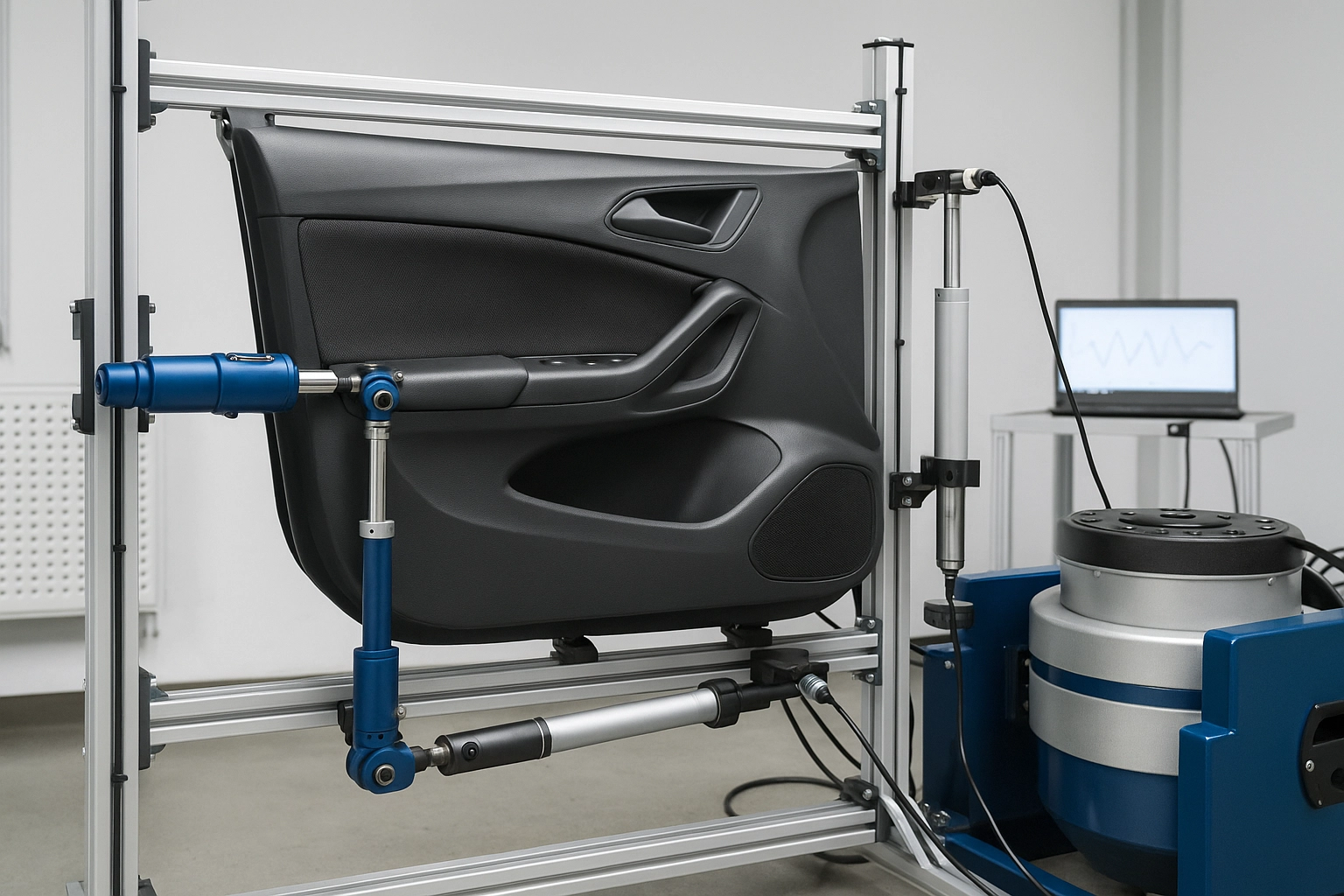JIS D1601 Road Simulation Buzz and Rattle Testing
The JIS D1601 test method is a critical procedure within the automotive industry designed to assess the potential for buzz, squeak, and rattle (BSR) issues in vehicle components. This testing ensures that vehicles meet stringent noise, vibration, and harshness (NVH) requirements set forth by Japanese Industrial Standards (JIS). BSR issues can significantly impact a vehicle's reputation and customer satisfaction; thus, this test is essential for quality assurance.
The JIS D1601 standard specifies road simulation tests that mimic real-world driving conditions to evaluate the noise produced by various components such as door panels, trim materials, and other interior parts. It focuses on identifying sources of undesirable sounds during vehicle operation. By conducting this test, manufacturers can ensure their products perform reliably under typical operating conditions without compromising comfort or safety.
The road simulation test follows a controlled environment where the specimen is subjected to various frequencies and amplitudes representing different driving scenarios. This helps engineers pinpoint specific areas requiring improvement before mass production begins. The process typically involves mounting the component onto an oscillating table that reproduces the motion experienced by the part in actual use, along with sound measurement instruments.
Compliance with JIS D1601 is crucial for companies aiming to meet Japanese market demands and maintain a good reputation among consumers who value high-quality vehicles. Non-compliance could lead to product recalls or lawsuits related to product quality issues.
To ensure accurate testing results, it's important to follow the specified procedures outlined in JIS D1601 strictly. These include selecting appropriate mounting methods for each component type, setting up the test rig correctly, calibrating all measurement equipment prior to use, and ensuring that environmental factors like temperature and humidity do not interfere with the tests.
Understanding the scope of this testing is fundamental when considering its implementation in an automotive R&D or production facility. Here's a summary provided by the JIS D1601 standard itself:
| Scope | Description |
|---|---|
| Component Testing | Includes door panels, trim materials, and other interior parts. |
| Driving Conditions Simulation | Mimics real-world driving scenarios to evaluate noise levels accurately. |
| Data Collection | Records both sound pressure level (SPL) and frequency content for analysis. |
The methodology described in JIS D1601 provides a structured approach to performing these tests. It involves mounting the component onto an oscillating table, adjusting the amplitude and frequency according to predetermined parameters, and recording SPLs at various points around the test area using specialized microphones.
Once testing is complete, analysts compare recorded data against established thresholds defined by JIS D1601 to determine whether the specimen meets acceptable noise limits. If discrepancies are found, further investigation into potential sources of BSR can be conducted, leading to targeted improvements in design or manufacturing processes.
For manufacturers focused on ensuring their products meet international standards and customer expectations regarding comfort and performance, implementing JIS D1601 testing is non-negotiable. It plays a vital role in maintaining brand integrity while enhancing overall product quality.
Scope and Methodology
| Scope | Description |
|---|---|
| Component Testing | This includes door panels, trim materials, and other interior parts. |
| Driving Conditions Simulation | Mimics real-world driving scenarios to evaluate noise levels accurately. |
| Data Collection | Records both sound pressure level (SPL) and frequency content for analysis. |
The methodology described in JIS D1601 provides a structured approach to performing these tests. It involves mounting the component onto an oscillating table, adjusting the amplitude and frequency according to predetermined parameters, and recording SPLs at various points around the test area using specialized microphones.
Once testing is complete, analysts compare recorded data against established thresholds defined by JIS D1601 to determine whether the specimen meets acceptable noise limits. If discrepancies are found, further investigation into potential sources of BSR can be conducted, leading to targeted improvements in design or manufacturing processes.
Industry Applications
| Application Area | Description |
|---|---|
| Automotive Interior Parts | Evaluating the noise generated by door panels, trim materials, and other interior components. |
| Vehicle Assembly Lines | Identifying early-stage issues that could affect final product quality before mass production begins. |
| R&D Facilities | Supporting research efforts aimed at reducing BSR while enhancing overall vehicle comfort and performance. |
The JIS D1601 test plays a crucial role in several aspects of the automotive industry. For instance, it helps identify early-stage issues that could affect final product quality before mass production begins on assembly lines. In R&D facilities, this testing supports research efforts aimed at reducing BSR while enhancing overall vehicle comfort and performance.
Automotive manufacturers can leverage JIS D1601 road simulation buzz and rattle testing to ensure their products meet international standards and customer expectations regarding comfort and performance. By implementing these tests early in the development process, companies can avoid costly recalls or lawsuits related to product quality issues.
Why Choose This Test
- Ensures compliance with JIS D1601 standards.
- Mimics real-world driving conditions accurately.
- Identifies early-stage issues before mass production begins on assembly lines.
- Supports research efforts aimed at reducing BSR while enhancing overall vehicle comfort and performance.
Selecting JIS D1601 road simulation buzz and rattle testing offers numerous advantages for automotive manufacturers. Firstly, it ensures compliance with stringent Japanese Industrial Standards (JIS), which is essential for companies aiming to meet market demands and maintain a good reputation among consumers who value high-quality vehicles.
Secondly, the test mimics real-world driving conditions accurately, providing reliable data that helps engineers pinpoint specific areas requiring improvement. Thirdly, by identifying issues early in the development process, manufacturers can avoid costly recalls or lawsuits related to product quality problems. Lastly, this testing supports research efforts aimed at reducing BSR while enhancing overall vehicle comfort and performance.





